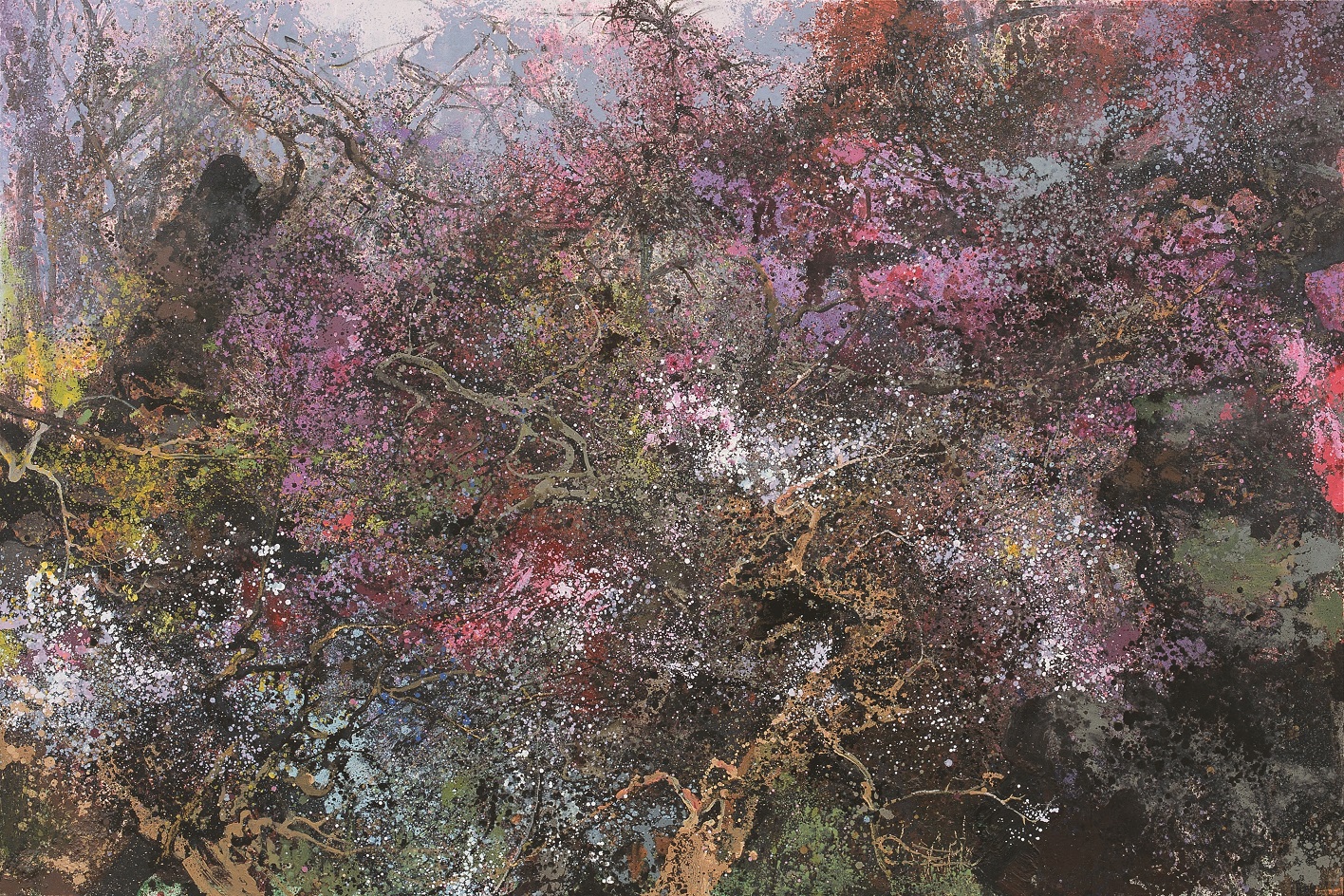
Hong Ling: A Retrospective displays one of China’s foremost artists, an innovative landscape painter who has only recently been recognised in any substantial way in the West. His first UK exhibition came only in 2012, and this retrospective follows as his second. Having begun in the Brunei Gallery, it has now arrived at the Chester Beatty.
Ling combines European and Chinese traditions in his work. He has worked mostly with oil painting, which was only introduced to China two or three centuries ago and is still regarded as very foreign to a national tradition reliant on ink. His later work, however, has shown a return to the more traditional medium. The exhibition notes tell us that there are intersections between the two methods in his paintings: he brings the scale and composition of oil paintings into ink, and thins oil paints to “achieve calligraphic lines”.
Ling suffered from the Cultural Revolution before his career, being sent along with millions of others to work hard labour in rural fields. After Mao’s death in 1976, he enrolled in the Beijing Capital Normal University, studying oil painting. His graduation work, “Figure 8” (1986) secured him a teaching position in the Chinese Academy of Fine Arts in Beijing.
Several critics remark that Ling is not a “modern” painter. However, he is best at what contemporary painters aren’t. He professes Turner and Modigliani as his primary European influences, though his early landscapes have a touch of Cezanne’s texture of form and colour. He may not be modern, but he’s certainly unique. His latest landscapes are vibrant testimonies to this.
He writes prefaces to the catalogue by lamenting the loss of respect afforded to nature in modern-day China. His paintings seek to reconstitute nature’s awesome sway over our minds.
The opening painting “A Peak of Reds” (2014) depicts trees set afire with gleaming oranges and reds, stretching up like a blaze towards the charcoal sky. This brilliant effect of counterpoint aptly introduces an artist who has a deeply innovative genius for colour. “Drunk in Frozen Forests” (2011) is another delightfully delirious work, clearly belonging to the same period. A splendour of early winter colours – vivid oranges and reds – dynamically dominate the foreground as the cold mountain peaks and sky lie hazily distant. Perspective is played with in “Pine Trunks: Bones” (2014): the scene is shot upwards, straight up towards the thick forest treetops, as the sky’s pale blues merely eek through the gaps between the towering trunks and glowing pink bloom.
To focus on his earlier paintings, the aforementioned graduation work, “Figure 8” (1986), a female nude painted with dry, flicked brushstrokes, is technically adept, but seems like an academic, imitative piece recalling Morandi or other early Modernist figures. The painting could have been lying around any studio in 1910s Paris or Vienna. He blames these forays into modernist imitation on “interference from artistic trends”. His heart has always belonged to landscape paintings. It’s in this genre that he excels as a truly unique artist. Landscape paintings in China arise from the shen shui tradition, which is landscape painted to express mood and philosophical ideas. Although usually painted in monochrome ink, Ling’s 1990s landscapes follow a kind of impressionistic tradition. However, Ling clearly began to develop his independent style in these works. “Cold Snow” (1991) is very skillfully composed of cold, misty blue and off-white tones, and is impressionistic in the truest sense in that you really do have the impression of wandering in solitude, lost in a Chinese forest on an early, foggy winter morning, breathing in the chilly white air.
“Four Seasons” (2000-2001) is a quadriptych that marks a break from his earlier naturalistic style in order to create a condensed painting using rich tones for each of the seasons. The four works together concentrate Ling’s earlier works into a succinct narrative of human mood throughout the year’s cycle, expressed in the change from hot and vivid to stark and cold palettes.
Although he has moved in the last few years to a more minimalist and even monochrome style using ink, his 2015 work “Rainbow-like” stands out as the most variegated piece. This work tends strongly towards the abstract, partially using drip painting techniques. Its composition is cluttered with clashing colours. A cloudy swathe of vivid pink courses through the indistinct trees and their straggle of branches, strangely evoking the colouring of Alma-Tadema’s paintings.
The last works of the exhibition have the merit of the unexpected: after all the sensuous experiments in colour and tone, these paintings, all ink-based, are almost wholly monochrome and instinct with a gloomy, metaphysical mood, giving the impression of an artist settling into a career-closing stage of muted expression and spiritual meditation. His “Diffuse Spring” (2014) seems ironically titled, as the spring colours are anything but diffuse. The season is instead represented by a few opaque drops of yellows and reds, with a subtle snatch of colour in the sky in what is otherwise a predominantly black-and-white picture. The last painting, “Lone Skiff, Night Rain” (2016), depicts a boatman with a face made only of wispy lines of ink on a journey under the light rain. It would be too crassly Eurocentric to see Charon the ferryman in him, but he looks as if he will soon dissolve into the clammy nothingness of the black and grey.
Hong Ling: A Retrospective is an exhibition worth a visit for anyone from a burgeoning art critic, to a student with a passing fancy in aesthetic prowess.






